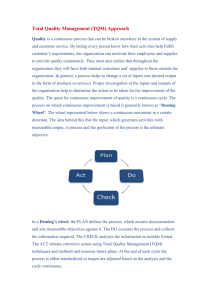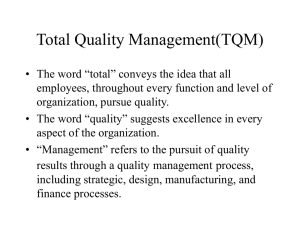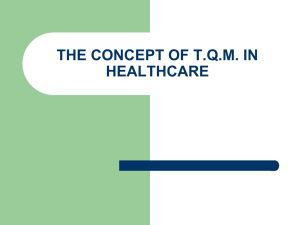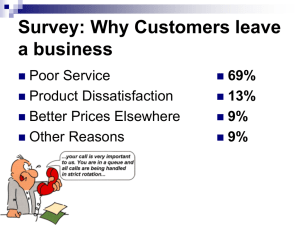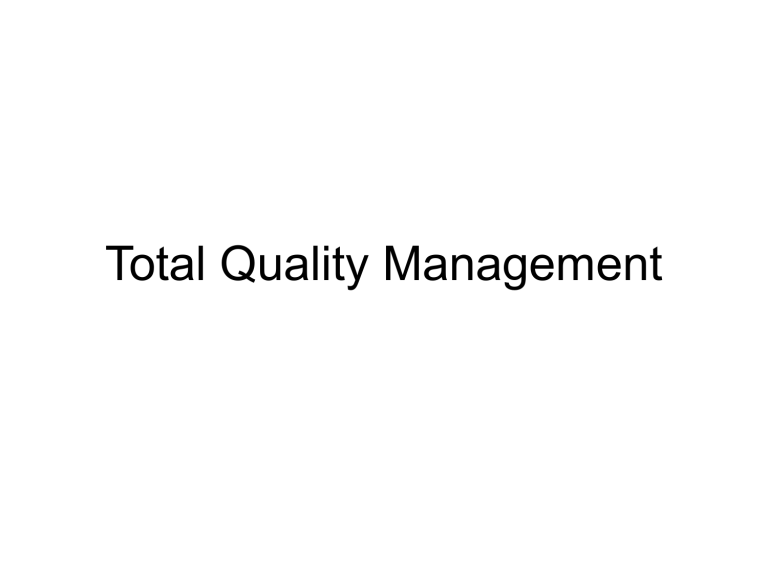
Total Quality Management Introduction “Quality is customer satisfaction,” “Quality is Fitness for Use.” • The American National Standards Institute (ANSI) and The American Society for Quality (ASQ) define quality as: “The totality of features and characteristics of a product or service that bears on its ability to satisfy given needs.” 2 Introduction • What is TQM? A comprehensive, organization-wise effort to improve the quality of products and services, applicable to all organizations. 3 Total Involvement & Input of everyone in the Organization. Top management to its Emplyoees. Quality Fully meeting customer needs and requirements all the time. Management Way we act & operate our policies & procedures including our training and instruction to all our employees. 4 History of quality management …To know the future, know the past! • Before Industrial Revolution, skilled craftsmen served both as manufacturers and inspectors, building quality into their products through their considerable pride in their workmanship. • Industrial Revolution changed this basic concept to interchangeable parts. Likes of Thomas Jefferson and F. W. Taylor (“scientific management” fame) emphasized on production efficiency and decomposed jobs into smaller work tasks. Holistic nature of manufacturing rejected! 5 History of quality management • Statistical approaches to quality control started at Western Electric with the separation of inspection division. Pioneers like Walter Shewhart, George Edwards, W. Edwards Deming and Joseph M. Juran were all employees of Western Electric. • After World War II, under General MacArthur's Japan rebuilding plan, Deming and Juran went to Japan. • Deming and Juran introduced statistical quality control theory to Japanese industry. 6 History of quality management • The difference between approaches to quality in USA and Japan: Deming and Juran were able to convince the top managers the importance of quality. • Next 20 odd years, when top managers in USA focused on marketing, production quantity and financial performance, Japanese managers improved quality at an unprecedented rate. • Market started preferring Japanese products and American companies suffered immensely. • America woke up to the quality revolution in early 1980s. Ford Motor Company consulted Dr. Deming to help transform its operations. (By then, 80-year-old Deming was virtually unknown in USA. Whereas Japanese government had instituted The Deming Prize for Quality in 1950.) 7 History of quality management • Managers started to realize that “quality of management” is more important than “management of quality.” Birth of the term Total Quality Management (TQM). • TQM – Integration of quality principles into organization’s management systems. • Early 1990s: Quality management principles started finding their way in service industry. FedEx, The Ritz-Carton Hotel Company were the quality leaders. • TQM recognized worldwide: Countries like Korea, India, Spain and Brazil are mounting efforts to increase quality awareness. 8 Principles of Total Quality Management (TQM) • TQM is broadly based on the following principles: 1. Customer Centric Approach – Consumers are the ultimate judge to determine whether products or services are of superior quality or not. No matter how many resources are pooled in training employees, upgrading machines and computers, incorporating quality design process and standards, bringing new technology, etc.; at the end of the day, it is the customers who have the final say in judging your company. Companies must remember to implement TQM across all fronts keeping in mind the customers. 9 2. Employee Involvement – Ensuring total employee involvement in achieving goals and business objectives will lead to employee empowerment and active participation from the employees in decision making and addressing quality related problems. Employee empowerment and involvement can be increased by making the workspace more open and devoid of fear. 3. Continual Improvement – A major component of TQM is continual improvement. Continual improvement will lead to improved and higher quality processes. Continual improvement will ensure companies will find new ways and techniques in producing better quality products, production, be more competitive, as well as exceed customer expectations. 10 4. Strategic Approach to Improvement – Businesses must adopt a strategic approach towards quality improvement to achieve their goals, vision, and mission. A strategic plan is very necessary to ensure quality becomes the core aspect of all business processes. 5. Integrated System – Businesses comprise of various departments with different functionality purposes. These functionalities are interconnected with various horizontal processes TQM focuses on. Everyone in the company should have a thorough understanding of the quality policies, standards, objectives, and important processes. It is very important to promote a quality work culture as it helps to achieve excellence and surpass customer expectations. An integrated system ensures continual improvement and helps companies achieve a competitive edge 11 6. Decision Making – Data from the performance measurement of processes indicates the current health of the company. For efficient TQM, companies must collect and analyze data to improve quality, decision making accuracy, and forecasts. The decision making must be statistically and situational based in order to avoid any room for emotional based decisions. 7. Communications – Communication plays a crucial role in TQM as it helps to motivate employees and improve their morale during routine daily operations. Employees need to be involved as much as possible in the day to day operations and decision making process to really give them a sense of empowerment. This creates the environment of success and unity and helps drive the results the TQM process can achieve. 12 The Difference Between Traditional & Total Quality Management Quality Defined by Company vs. Customer With traditional quality management, the company defines its quality standards and determines whether a particular product is acceptable. In total quality management, customers determine a product’s quality. A company can change its standards, train employees or revise its processes, but if customers aren’t satisfied, then the organization isn’t producing a quality product. Emphasizing Short-Term vs. Long-Term Success Traditional quality management emphasizes the achievement of short-term objectives, such as the number of products produced or profits earned in a quarter. Total quality management looks at long-term improvements in how a product is produced and the sustained satisfaction of customers. 13 Improving People vs. Improving Processes If defects are found through traditional quality management, managers identify who is responsible and hold them accountable. With total quality management, managers and employees look at how they can improve quality by changing the processes used to produce a product. Managing With Fear vs. Motivating With Rewards In traditional quality management, managers rely their on authority as supervisors to tell employees what to do. They may even use fear to motivate and threaten to discipline or even to fire employees. In total quality management, employees are given opportunities to improve themselves. They are rewarded for the achievement of individual, departmental or organizational goals. 14 Accountability of the Few vs. Responsibility of the Many With traditional management, only the employees who are directly involved in producing a product are responsible for its quality. With total quality management, everyone in an organization – including the top executives – are responsible for the quality of each product that the company produces. Acting on Instincts vs. Deciding by Facts In traditional quality management, supervisors and employees solve problems and act based on their individual knowledge, skills and instincts. In total quality management, multiple employees, teams or departments solve problems and make decisions based on substantive data. Isolation vs. Cooperation Each employee has a specific role that is narrowly defined by a supervisor in traditional quality management. Total quality management involves managers and employees working together in an integrated capacity that involves more than one role or responsibility at a time. 15 Correcting Errors vs. Getting It Right the First Time Traditional quality management requires the reproduction of any product with defects. Total quality management emphasizes eliminating waste and increasing efficiencies so that a product is produced correctly the first time. Fighting Fires vs. Continuously Improving Traditional quality management addresses problems as they arise, resolving them on a case-by-case basis. Total quality management emphasizes continuous process improvement, resolving issues systematically. 16 Thank You 17
